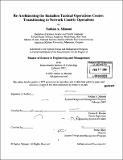| dc.contributor.advisor | Donna H. Rhodes. | en_US |
| dc.contributor.author | Minami, Nathan A. (Nathan Andrew) | en_US |
| dc.contributor.other | System Design and Management Program. | en_US |
| dc.date.accessioned | 2008-09-03T15:28:04Z | |
| dc.date.available | 2008-09-03T15:28:04Z | |
| dc.date.copyright | 2007 | en_US |
| dc.date.issued | 2007 | en_US |
| dc.identifier.uri | http://hdl.handle.net/1721.1/42370 | |
| dc.description | Thesis (S.M.)--Massachusetts Institute of Technology, System Design and Management Program, 2007. | en_US |
| dc.description | Includes bibliographical references (leaves 128-134). | en_US |
| dc.description.abstract | As the Army conducts transformation in the midst of an ongoing information driven Revolution in Military Affairs (RMA) and the War on Terror, it has realized the need to develop leaner, more agile, versatile and deployable forces. As part of its latest transformation to Brigade "Units of Action," the Army realized the need to improve the "tooth to tail" ratio of its forces and transferred from a Cold War "Divisional" force structure to one focused around more deployable and sustainable Brigade Units of Action. Ironically, this transformation to what is suppose to become a more lean and deployable force structure has produced larger and more heavily staffed battalion, brigade and division command posts. Despite introduction of the Army Battle Command System (ABCS), a system of digital systems that are intended to help speed up the Army's ability to transfer information, improve situational awareness, make decisions, and out "OODA" (Observe-Orient-Decide-Act) its opponents, in many aspects the Army has actually taken a step backwards. The end result is that these larger command posts are becoming more hierarchical and bureaucratic, and are reducing the Army's ability to get ahead of the enemy's decision cycle. Platoon Leaders and Company Commanders in Iraq and Afghanistan constantly lament that "if they only had the information they needed 48 hours earlier," they could have captured the target. This study examines one small aspect of this tremendous problem, the architecture of the Battalion Tactical Operations Center (TOC). It analyzes the current information revolution, the contemporary operating environment, network centric warfare, other emerging Revolution in Military Affairs (RMA) concepts, and the current Battalion TOC configuration and doctrine. It then applies System Dynamics techniques and develops a set of heuristics to address the problem. The ultimate goal of this study is to develop a practical concept for an improved organization, structure and function of the command post. | en_US |
| dc.description.statementofresponsibility | by Nathan A. Minami. | en_US |
| dc.format.extent | 134 leaves | en_US |
| dc.language.iso | eng | en_US |
| dc.publisher | Massachusetts Institute of Technology | en_US |
| dc.rights | M.I.T. theses are protected by
copyright. They may be viewed from this source for any purpose, but
reproduction or distribution in any format is prohibited without written
permission. See provided URL for inquiries about permission. | en_US |
| dc.rights.uri | http://dspace.mit.edu/handle/1721.1/7582 | en_US |
| dc.subject | System Design and Management Program. | en_US |
| dc.title | Re-architecting the Battalion Tactical Operations Center : transitioning to network centric operations | en_US |
| dc.title.alternative | Re-architecting the Battalion TOC : transitioning to network centric operations | en_US |
| dc.type | Thesis | en_US |
| dc.description.degree | S.M. | en_US |
| dc.contributor.department | System Design and Management Program. | en_US |
| dc.identifier.oclc | 234381134 | en_US |
